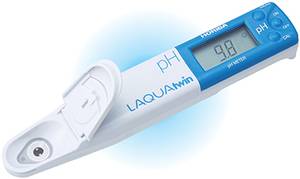


Proper usage and maintenance of the LAQUAtwin pH meter, especially the pH sensor that comes in contact with samples, is important to maintain the accuracy and prolong the life span of the instrument.
Materials Needed
|
|
|
|
|
|
Conditioning
A dry pH sensor may give erratic reading or slow response. Condition the pH sensor before using it for the first time and after storing it dry. If there is white powder or salt buildup on the junction after dry storage, simply rinse off with water. This is normal.
Cleaning
A clean pH sensor is necessary for performing an accurate pH measurement. The cleaning solution will depend on what sample was tested with the sensor.
Read the safety data sheet (SDS) of the cleaning solution to be used and wear the proper personal protective equipment before handling. Download the SDSs of HORIBA cleaning solutions at www.horiba-laqua.com.
If calibration with fresh buffers failed repeatedly and cleaning did not restore the pH sensor performance, replace the pH sensor with a new one (Model S010, Part no. 3200459834). The pH sensor is a consumable product and its performance deteriorates over time even under normal operating condition.
If disinfection is needed, wipe the surface of meter body and sensor with a clean cloth wet with ethanol or use alcohol wipes. For the flat sensor, place drops of 5% sodium hypochlorite (NaClO) solution for 5 to 30 minutes then rinse thoroughly with sterile water.
Storage
Store the clean pH sensor in dry condition. Never leave distilled or deionized water on the pH sensor for long period as salts may leach out and reduce sensor life. Condition the pH sensor prior to next use (See Conditioning).
Tiene alguna pregunta o solicitud? Utilice este formulario para ponerse en contacto con nuestros especialistas.
HORIBA Advanced Techno, Co., Ltd.
31, Miyanonishi-cho, Kisshoin
Minami-ku Kyoto 601-8306 Japan
Tel: +(81) 75 321 7184
Fax: +(81) 75 321 7291
HORIBA Instruments (Singapore) Pte Ltd.
83 Science Park Drive, #02-02A,
The Curie 118258 Singapore
Tel: +65 6 908 9660
Fax: +65 6 745 8155
Mail: laqua(at)horiba.com
HORIBA UK Limited Northampton Office
Kyoto Close,Summerhouse Road,
Moulton Park
Northampton NN3 6FL UK
Tel: +(44) 1604 542 600
Fax: +(44) 1604 542 699
Mail: waterquality(at)horiba.com
HORIBA Instruments Incorporated Head Office
9755 Research Drive
Irvine California 92618 USA
Tel: +1 800 446 7422
Fax: +1 949 468 1790
Mail: labinfo(at)horiba.com
You might also like to know...
![]()
![]()
![]()
![]()
![]()
![]()
![]()
![]()
![]()